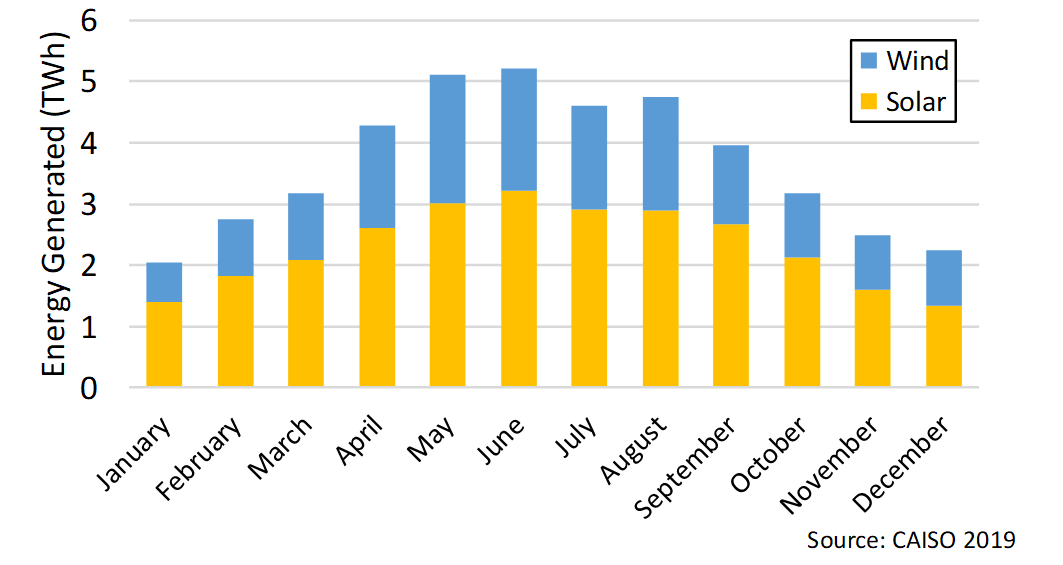Summary
- High penetration of variable renewables requires short-term and seasonal storage
- A promising option is to use excess renewable power to produce hydrogen or “synthetic natural gas” which can be stored for later usage.
- Power-to-gas needs much of the same infrastructure as gas-to-power, thus limiting risks of climate stranded assets.
The need for long-term energy storage in a high-renewables world
Falling costs offer hope that batteries will soon be able to manage wind and solar intermittency on timescales of hours and even days.1 The larger challenge as renewable shares grow will be to smooth out variability in renewable output on timescales of weeks and months. Seasonal variability in wind and solar, as illustrated for the case of California in Figure 1, will require technologies that are more cost-effective than batteries for long-term energy storage. The immediate need may seem to come from rich jurisdictions like California, which targets 50% renewable generation in 2026 and 60% in 2030. However, because developing countries are building out their grids from a low base, high shares of renewable energy are arriving even sooner. Already, some fast-growing countries in Africa and Asia are having to delay some renewable developments because their grids can’t handle the variation in output.
Figure 1: Seasonal variation of wind and solar output in California, 2018

Current options for long-term storage: pumped hydro… and not much else
Pumped-storage hydroelectricity (“pumped hydro”) accounts for 96% of the total power output capacity of energy storage worldwide.2,3 Pumped hydro involves pumping water to a reservoir at a higher elevation when electrical power is plentiful, and then, when power is needed, allowing the water to flow down to a lower reservoir through a turbine that generates electricity. Pumped hydro can store energy for long time periods, but its global output capacity of 170 GW is a fraction of total power generating capacity, which is over 3000 GW in OECD countries alone.4 In theory, there is room to expand pumped hydro capacity, but in practice, the land requirements make new facilities difficult to site and build in most countries.5
Power-to-gas (and its challenges)
Power-to-gas is another technology option for long-term energy storage. Excess power from when renewable resources are plentiful can be used to break water into hydrogen and oxygen in a process called electrolysis. The hydrogen can further be converted into methane (or “synthetic natural gas”) via a methanation reaction that combines CO2 and H2 to form CH4. Either hydrogen or methane can be stored until their energy is needed, at which point the energy can be extracted in a fuel cell (for hydrogen) or through combustion (for methane).
Neither electrolysis nor methanation are yet close to cost-competitive. These conversion processes are especially difficult and costly to run in an intermittent mode. They have low “round-trip efficiency” of storing and then re-generating electricity: an estimated 34-44% for the hydrogen pathway and 30-38% for the methane pathway.6 Research, development, and pilot deployment of these technologies is needed to drive down costs, supported by carbon pricing that adequately values the climate benefits of power-to-gas (as well as “renewable gas” from sources like landfills and wastewater treatment facilities).
Implications of the power-to-gas vision for developing countries
For all its challenges, power-to-gas appears to be the most promising option—perhaps the only option—to manage the seasonal variation of renewable energy at scale. Developed countries like Germany and South Korea are leading the way in pursuing demonstration projects, but the long-term power-to-gas vision also has implications for developing countries.7 Specifically, it contributes to a broader logic for natural gas development, as follows:
- Natural gas is needed for power generation and industry in developing countries. Multilateral lenders are shying away from supporting high-emitting coal, but there are limited other options for energy at scale. Gas is, environmentally, far preferable to coal.
- Natural gas is needed to back up wind and solar in developing countries. An under-appreciated story is how quickly some developing countries are reaching shares of renewable generation that make grid integration difficult. Gas could play a key role in managing short- and long-term variation in wind and solar output.
- Power-to-gas means gas infrastructure doesn’t have to end up “climate-stranded.” The biggest challenge in developing a domestic gas market is building expensive pipelines, storage, and import facilities for gas. The environmental concern is that this infrastructure could “lock in” reliance on a greenhouse-gas-emitting fossil fuel. But this doesn’t have to be the case. The same infrastructure used to transport and store natural gas today can be used to realize a zero-carbon vision in the future—a vision that relies on power-to-gas based on synthetic methane (and other renewable gas) to support intermittent, zero-carbon electricity.
Endnote
- Claudia Pavarini, “Battery storage is (almost) ready to play the flexibility game,” IEA, February 7, 2019,
- IRENA, “Electricity Storage and Renewables: Costs and Markets to 2030,” October
- DOE Global Energy Storage Database
- IEA, Electricity Information 2019.
- Matt Stocks, “Global pumped hydro atlas.”
- Fraunhofer IWES, “Energiewirtschaftliche und ökologische Bewertung eines Windgas-Angebotes,” February 2011, (in German)
- Julian Wettengel, “Germany could have 7.5 GW power-to-gas capacity by 2030, say gas grid operators,” Clean Energy Wire, June 18, 2019
